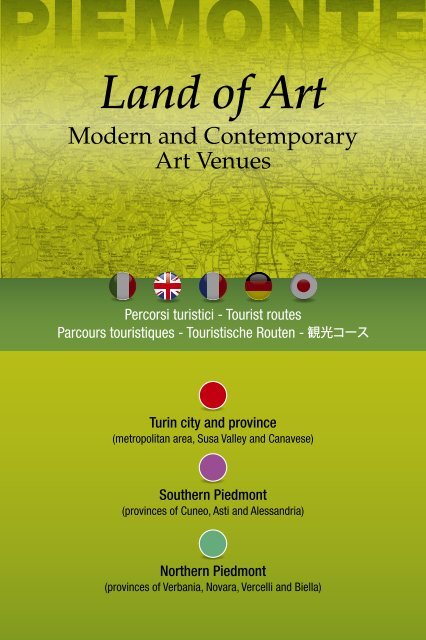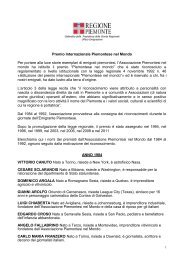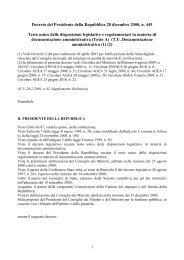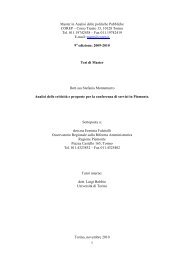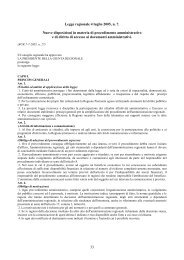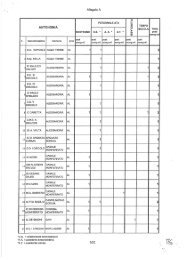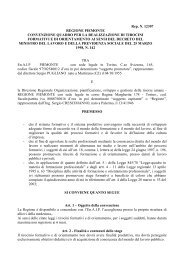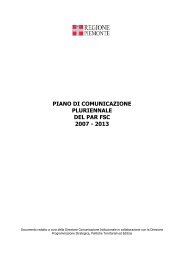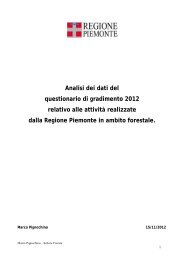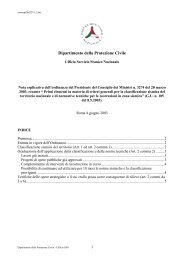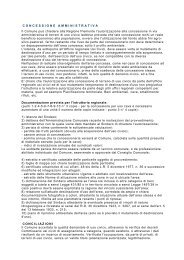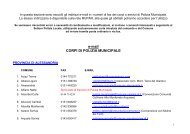Land of Art - Regione Piemonte
Land of Art - Regione Piemonte
Land of Art - Regione Piemonte
You also want an ePaper? Increase the reach of your titles
YUMPU automatically turns print PDFs into web optimized ePapers that Google loves.
IEMONTE<br />
<strong>Land</strong> <strong>of</strong> <strong>Art</strong><br />
Modern and Contemporary<br />
<strong>Art</strong> Venues<br />
Percorsi turistici - Tourist routes<br />
Parcours touristiques - Touristische Routen -<br />
Turin city and province<br />
(metropolitan area, Susa Valley and Canavese)<br />
Southern Piedmont<br />
(provinces <strong>of</strong> Cuneo, Asti and Alessandria)<br />
Northern Piedmont<br />
(provinces <strong>of</strong> Verbania, Novara, Vercelli and Biella)
31<br />
32<br />
3<br />
34<br />
35<br />
36<br />
37<br />
38<br />
39<br />
310<br />
311<br />
Index<br />
TURIN CITY AND PROVINCE<br />
Turin and the metropolitan area page 2<br />
The ancient capital looks to the future<br />
Susa Valley page 10<br />
Sacred and pr<strong>of</strong>ane masterpieces<br />
The Canavese region page 11<br />
Where art comes naturally<br />
SOUTHERN PIEDMONT<br />
Caraglio and Saluzzo page 12<br />
Making way for cultural excellence<br />
Langhe and Roero page 14<br />
The hidden soul <strong>of</strong> the hills<br />
Alessandria and Casale Monferrato page 16<br />
A stroll, amidst hats and sculptures<br />
Asti and Bubbio page 18<br />
<strong>Art</strong> in towns and vineyards<br />
NORTHERN PIEDMONT<br />
Vercelli page 20<br />
A veritable treasure chest<br />
Novara and the surrounding area page 22<br />
Contemporary art and “renaissance” workshops<br />
Lake district page 24<br />
Where Nature meets <strong>Art</strong><br />
Biella and the Wool Road page 26<br />
Between past and future<br />
P
IEMONTE<br />
<strong>Land</strong> <strong>of</strong> <strong>Art</strong><br />
8 · 9<br />
10 · 11 Piedmont is synonymous with history, art and culture,<br />
boasting as it does an amazing architectural<br />
1 · 2 · 3<br />
heritage, inclusive <strong>of</strong> Roman ruins, Baroque buildings,<br />
<strong>Art</strong> Nouveau and contemporary styles.<br />
Turin is one <strong>of</strong> the leading European cities <strong>of</strong> contempo-<br />
4 · 5 · 6 · 7<br />
rary art. In recent years, Piedmont has gained significant<br />
credibility for its continuous, high pr<strong>of</strong>ile activities to the<br />
public. This success is the result <strong>of</strong> years <strong>of</strong> work and <strong>of</strong> the combined<br />
efforts <strong>of</strong> public institutes and private bodies. Considerable resources<br />
have been invested since 2007 to create a veritable contemporary art system in<br />
Turin and Piedmont. Contemporary<strong>Art</strong> Torino + <strong>Piemonte</strong> promotes concerts<br />
and visual and performing art performances with a well-defined contemporary<br />
identity, with a special focus on research, innovation and experimentation.<br />
This guidebook <strong>of</strong>fers a very unusual characterisation <strong>of</strong> Piedmont’s cultural<br />
heritage, which is traditionally associated with the Baroque age, whereas the<br />
modern image <strong>of</strong> Piedmont is usually linked to Olivetti, the computer company<br />
based in Ivrea, and Fiat, the Turin car manufacturing company.<br />
A constellation <strong>of</strong> striking territories, world-renowned authors, en plen air<br />
works <strong>of</strong> art, international events, public art and architectural masterpieces dictate<br />
the region’s modern and contemporary history.<br />
A major role is played by GAM, the Gallery <strong>of</strong> Modern <strong>Art</strong>, which boasts<br />
a permanent collection with over 45,000 works, and the Museum <strong>of</strong> Contemporary<br />
<strong>Art</strong> in the Rivoli Castle, <strong>of</strong>fering an extraordinary juxtaposition<br />
between the old Savoy residence redesigned by Filippo Juvarra and the works<br />
<strong>of</strong> contemporary artists such as Vedova, Pistoletto, Paolini, Merz, Sol Lewitt,<br />
Long, Anselmo, Fabro, Kounellis.<br />
Equally important is the role played by a number <strong>of</strong> trusts dedicated to contemporary<br />
art, such as the Fondazione Sandretto Re Rebaudengo and the Fondazione<br />
Merz. Other important initiatives include: Cittadellarte, founded by<br />
Michelangelo Pistoletto in Biella, which can be described as “new kind <strong>of</strong> artistic<br />
institution that allows art to interact directly with the different sectors <strong>of</strong><br />
society”; the old spinning mill in Caraglio, transformed into a cultural centre<br />
for theme-based exhibitions; Arca, in Vercelli, a venue hosting prestigious exhibitions<br />
<strong>of</strong> the Fondazione Guggenheim; and the historical gallery run by the<br />
art dealer Franz Paludetto, which has recently moved to the Rivara Castle.<br />
The aim <strong>of</strong> the project is to combine the cultural tourism associated with the region’s<br />
modern and contemporary architecture with a greater focus on the local<br />
territory, <strong>of</strong>fering a number <strong>of</strong> unusual itineraries, for an “ever-new Piedmont”.<br />
www.contemporarytorinopiemonte.it<br />
www.piemonteitalia.eu
© Marco Saroldi - Fondazione Torino Musei<br />
2<br />
www.turismotorino.org<br />
Turin<br />
and the metropolitan area<br />
The ancient capital looks to the future<br />
GPs Turin<br />
Lat. 45°04'23"N<br />
Long. 7°40'51"E<br />
TURIN<br />
† Turin, GAM,<br />
Penone, In Limine<br />
The city <strong>of</strong> Turin is the perfect melting pot <strong>of</strong> modern and<br />
contemporary art, in its multiple expressions and endless opportunities<br />
for renewal and contamination. Our aim is to<br />
guide you through the best the city can <strong>of</strong>fer in this sense.<br />
museums<br />
Gam<br />
Galleria Civica d’<strong>Art</strong>e Moderna e Contemporanea<br />
Turin - via Magenta, 31 - Ph. +39 011 4429518<br />
Info: open Tuesdays to Sundays, 10.00 - 18.00<br />
(the ticket <strong>of</strong>fice closes at 17.00).<br />
www.gamtorino.it<br />
GAM – Civic Gallery <strong>of</strong> Modern and Contemporary <strong>Art</strong> – is<br />
one <strong>of</strong> Italy’s oldest and most important modern and contemporary<br />
art museums. Indeed, Turin was the first Italian city<br />
to promote a public collection <strong>of</strong> modern art, in 1863, as part <strong>of</strong><br />
its Civic Museum. Today its collections consist in over 45,000<br />
works, including paintings, sculptures, installations and photographs,<br />
besides a rich collection <strong>of</strong> drawings and engravings<br />
and one <strong>of</strong> the most important European collections <strong>of</strong> art films<br />
and videos. The museum holds important works by major 19th and 20th century Italian and international artists, followers <strong>of</strong> the<br />
<strong>Art</strong>e Povera movement and <strong>of</strong> the new avant-garde <strong>of</strong> the second<br />
post-war period. These include works by Merz, Paolini, Boetti,<br />
Anselmo, Zorio, Penone and Pistoletto.<br />
GAM is surrounded by a pleasant sculpture garden with items<br />
by Melotti, Mainolfi, Cordero, Paolini and Penone. At night, a<br />
blue neon inscription reading “All <strong>Art</strong> Has Been Contemporary”,<br />
an installation by Maurizio Nannucci, shines out from the ro<strong>of</strong>.
TURIN CITY AND PROVINCE<br />
Fondazione Merz<br />
Turin - via Limone, 24 - Ph. +39 011 19719437<br />
Info: open Tuesdays to Sundays, 11.00 - 19.00<br />
(last entry 18.30).<br />
www.fondazionemerz.org<br />
Fondazione Merz, a trust dedicated to Mario Merz who died in<br />
Turin in 2003, inaugurated its exhibition space in April 2005.<br />
The trust is situated in the former thermal power station <strong>of</strong> the<br />
Lancia factory, a rationalist-style industrial building in what used<br />
to be a working class district. The three-storey building measures<br />
3,200 square metres in all, 1,400 <strong>of</strong> which are dedicated to the exhibition<br />
area. The trust also <strong>of</strong>fers a library open to the public and<br />
a bookshop with all the material published by Fondazione Merz.<br />
The trust organises scientific and theme-based exhibitions on<br />
Mario Merz and invites contemporary artists to exhibit their<br />
works alongside those <strong>of</strong> the famous exponent <strong>of</strong> the <strong>Art</strong>e Povera<br />
movement.<br />
Fondazione Sandretto Re Rebaudengo<br />
Turin - via Modane, 16 - Ph. +39 011 3797600<br />
Info: open Thursdays 20.00 - 23.00,<br />
Fridays to Sundays 12.00 - 19.00.<br />
www.fsrr.org<br />
In 2002, the Fondazione Sandretto Re Rebaudengo, established<br />
in 1995, inaugurated the large Centre <strong>of</strong> Contemporary<br />
<strong>Art</strong>, designed by Claudio Silvestrin. The neominimalist-style<br />
building has a large hall for temporary exhibitions, as well as an<br />
auditorium, a bookshop, an education room, a restaurant and a<br />
stylish cafeteria designed by Rudolf Stingel, from the Trentino<br />
Alto Adige region <strong>of</strong> Italy. The Centre, designed to address the<br />
latest contemporary issues, is a flexible venue suitable for events<br />
as well as concerts, theatre shows, movie screenings, literary<br />
meetings and discussions.<br />
31<br />
π Turin, Fondazione Merz<br />
π Turin, Fondazione Sandretto<br />
Re Rebaudengo<br />
© Eric Planchard - Turismo Torino e Provincia<br />
© Fondazione Sandretto Re Rebaudengo<br />
3
© Turismo Torino e Provincia<br />
© Michele Vacchiano - Città di Torino<br />
© Bruna Biamino - Città di Torino<br />
4<br />
π Castello di Rivoli<br />
π Turin, Pinacoteca Agnelli<br />
† Turin, Luci d’<strong>Art</strong>ista,<br />
Monte dei Cappuccini,<br />
Rebecca Horn<br />
Museo d’<strong>Art</strong>e Contemporanea<br />
Castello di Rivoli<br />
Rivoli - piazza Mafalda di Savoia - Ph. +39 011 9565222<br />
Info: open Tuesdays to Fridays, 10.00 - 17.00; Saturdays and<br />
Sundays, 10.00 -19.00 (the ticket <strong>of</strong>fice closes at 18.30 pm).<br />
www.castellodirivoli.org<br />
The Museum <strong>of</strong> Contemporary <strong>Art</strong> is situated in the Rivoli<br />
Castle, a baroque mansion designed in the early 18th century<br />
by Filippo Juvarra for King Vittorio Amedeo II. It is considered<br />
one <strong>of</strong> the most qualified institutes <strong>of</strong> contemporary art. As well<br />
as temporary international exhibitions, the museum houses a<br />
prestigious permanent collection <strong>of</strong> works from the 1950s to the<br />
present day, and boasts artists <strong>of</strong> the calibre <strong>of</strong> Sol LeWitt and<br />
Richard Long, as well as some <strong>of</strong> the main exponents <strong>of</strong> the <strong>Art</strong>e<br />
Povera and Transavantgarde movements. Manica Lunga, a 17th century Savoy picture gallery, also hosts temporary exhibitions in<br />
a 147m long space on the top floor.<br />
Pinacoteca Giovanni e Marella Agnelli<br />
Torino - via Nizza, 230 - Ph. +39 011 0062713<br />
Info: open Tuesdays to Sundays, 10.00 - 19.00<br />
(the ticket <strong>of</strong>fice closes at 18.15).<br />
www.pinacoteca-agnelli.it<br />
Inaugurated in 2002, the Giovanni and Marella Agnelli picture<br />
gallery is situated in a futuristic, parallelepiped-shaped venue<br />
suspended in mid-air above the ro<strong>of</strong>top test track <strong>of</strong> the former<br />
FIAT Lingotto plant. Nicknamed “Lo Scrigno”, or treasure<br />
chest, by its designer Renzo Piano, it house 25 masterpieces <strong>of</strong><br />
ancient and modern art, the oldest dating back to the 18th century<br />
and the most recent to the mid 20th century.<br />
en Plein air works <strong>of</strong> arT<br />
Luci d’<strong>Art</strong>ista in Turin<br />
www.contemporarytorinopiemonte.it<br />
First held in 1997, Luci d’<strong>Art</strong>ista is the world’s first outdoor<br />
light exhibition. Launched during the Christmas period, it<br />
soon expanded abroad, becoming a veritable en plen air exhibition<br />
<strong>of</strong> works by Italian and foreign artists. Some <strong>of</strong> the works are<br />
permanent, such as the Fibonacci series created by Mario Merz
on the dome <strong>of</strong> the Mole Antonelliana, Michelangelo Pistoletto’s<br />
installation on the ancient eaves <strong>of</strong> the clock tower in Porta<br />
Palazzo, and that by Marco Gastini in a vault <strong>of</strong> the Galleria Subalpina.<br />
These permanent works are switched on on special occasions,<br />
while alternating works by other artists, such as Buren,<br />
Casorati, Horn and Mainolfi, are installed every year.<br />
Public art<br />
www.contemporarytorinopiemonte.it<br />
Below are some <strong>of</strong> the most interesting en plein air sculptures<br />
and installations by artists <strong>of</strong> international repute, displayed<br />
in Turin over the past thirty years:<br />
La Fontanella di Venere<br />
(1997), by Enrica Borghi.<br />
Centro Congressi<br />
Torino Incontra<br />
Via Costa, 8.<br />
Punti di vista (2005),<br />
by Tony Cragg.<br />
Piazza D’Armi - Stadio Olimpico.<br />
Eco (2005),<br />
by Marc Didou.<br />
Via Sant’Ottavio, 20.<br />
Opera per Torino (2005),<br />
by Per Kirkeby.<br />
Largo Orbassano.<br />
Fontana Igloo (2002),<br />
by Mario Merz.<br />
Corso Lione - Corso<br />
Mediterraneo.<br />
Cantatore di arcobaleno (2000),<br />
by Mario Molinari.<br />
Ospedale Mauriziano<br />
Corso Filippo Turati.<br />
TURIN CITY AND PROVINCE<br />
Albero Giardino (2002),<br />
by Giuseppe Penone.<br />
Corso Mediterraneo -<br />
Corso Ferrucci.<br />
In Primo Luogo (1998),<br />
by Michelangelo Pistoletto.<br />
Centro Commerciale Garibaldi<br />
Via Garibaldi, 18.<br />
Cuneo con Frecce (2007),<br />
by Arnaldo Pomodoro.<br />
Corso XI Febbraio, 14.<br />
Sole Aerospazio (1989),<br />
by Giò Pomodoro.<br />
Giardini di Piazza Adriano.<br />
Locus Of rain (1995),<br />
by Susumu Shingu.<br />
Piazzale del Lingotto<br />
Via Nizza, 262.<br />
Abbraccio Infinito (1999),<br />
by Luigi Stoisa.<br />
Cortile Molasso<br />
Via Borgo Dora, 29.<br />
Reggia di Venaria Reale - Gardens<br />
Ph. +39 011 4992333<br />
Info: the gardens are open Tuesdays to Sundays, from 9 am to sunset.<br />
www.lavenaria.it<br />
The sculptor Giuseppe Penone has created 14 installations,<br />
made with different materials such as bronze and marble,<br />
in a 5-hectare area in the garden <strong>of</strong> Parco Basso in Reggia di Venaria.<br />
Each work is divided by small wooded areas, pools and<br />
fountains, <strong>of</strong>fering a reinterpretation, based on the original layout,<br />
<strong>of</strong> the former 17th century garden designed by Amedeo di<br />
Castellamonte, who had divided the garden into large squares.<br />
π Turin, Punti di vista<br />
by Tony Cragg<br />
π Turin, Fontana Igloo<br />
31<br />
by Mario Merz, along the<br />
“Spina” avenue<br />
† Venaria Reale,<br />
Giuseppe Penone<br />
© Città di Torino © Bruna Biamino - Città di Torino<br />
© Claudia Candeli - Città di Torino<br />
5
© Michele Vacchiano - Città di Torino © Giannese&Ramella - Fondazione Teatro Regio<br />
6<br />
π Turin, Teatro Regio<br />
† Turin, Santo Volto<br />
modern and conTemPorary<br />
archiTecTure<br />
Teatro Regio<br />
Turin - piazza Castello, 215 www.teatroregio.torino.it<br />
The love <strong>of</strong> architect Carlo Mollino for the curvy female<br />
figure can be seen in the symbolic correspondence between<br />
the theatre’s plan and the image <strong>of</strong> a female bust, more markedly<br />
in the curving walls <strong>of</strong> the staircases and less so in the great<br />
empty space <strong>of</strong> the ellipsoidal stalls. A detached gallery provides<br />
access to the hall, while two glass bridges connect the theatre to<br />
the foyer in the Alfieri wing.<br />
Torre Littoria<br />
Turin - via Viotti-piazza Castello<br />
The Littoria Tower, built between 1931and 1933 by Armando<br />
Melis de Villa, was the first structure in Turin to have<br />
an electro-welded metallic frame. The nine-storey tower, with<br />
a small bell tower on top, is situated above a ten-storey building,<br />
for a total height <strong>of</strong> 87 metres. The tower is covered with red<br />
brick stoneware and travertine slabs. The balconies, which are<br />
made <strong>of</strong> glass brick, have luminous panels under the windowsills<br />
to provide illumination at night.<br />
Santo Volto<br />
Turin - via Nole, con the corner with via Borgaro<br />
www.santovolto.com<br />
The Santo Volto parish church, designed by the Swiss architect<br />
Mario Botta, was built in an area which underwent<br />
considerable post-industrial transformation. Inaugurated in December<br />
2006, it features seven elements on the perimeter that<br />
rise towards the sky, like arms in search <strong>of</strong> the light. Light filters<br />
through seven skylights in the higher part <strong>of</strong> the ro<strong>of</strong> to illuminate<br />
the central area, while seven other skylights (lower than the<br />
first) provide light to the side chapels. The post-modern bell<br />
tower, which incorporates the former chimney <strong>of</strong> the ironworks<br />
and is decorated with a spire ascending from the earth up to the<br />
sky, houses nine chime bells. Most <strong>of</strong> the building is made with<br />
natural materials such as stone, brick and wood.
urban reconversion<br />
and olymPic works<br />
oGr - Officine Grandi Riparazioni<br />
Turin - corso Castelfidardo, 22<br />
www.<strong>of</strong>ficinegrandiriparazioni.it<br />
TURIN CITY AND PROVINCE<br />
Officine Grandi Riparazioni, built between 1885 and 1895,<br />
represents a particularly significant example <strong>of</strong> early industrial<br />
development in Turin. It was designed to be a state-<strong>of</strong>-the-art<br />
repair centre for railway engines and coaches, being close to the<br />
railway that connected Turin to Milan. Inside, rows <strong>of</strong> large castiron<br />
pillars remind viewers <strong>of</strong> impressive naves in a “cathedral”<br />
that pays tribute to Turin’s industrial history.<br />
The Officine was operational until the 1990s , when it was transformed<br />
into a large exhibition venue, measuring over 20,000<br />
square metres in size.<br />
mauTo - National Automobile Museum<br />
Turin - corso Unità d’Italia, 40 - Ph. +39 011 677666/7/8<br />
Info: open Mondays, 10.00-14.00; Tuesdays, 14.00-19.00;<br />
Wednesdays, Thursdays and Sundays, 10.00-19.00, Fridays and<br />
Saturdays, 10.00-21.00.<br />
www.museoauto.it<br />
The National Museum <strong>of</strong> Cars, built in 1958 by Amedeo Albertini,<br />
is situated on a hill that slopes towards the River Po. Special<br />
care and attention were placed in the design <strong>of</strong> vantage points<br />
and construction details. Reopened in 2011 following restoration<br />
by the architect Cino Zucchi, the museum’s outfitting has been<br />
further enhanced by the Swiss-French designer François Confino.<br />
Lingotto multipurpose centre<br />
Turin - via Nizza, 230<br />
The 1920s FIAT car factory was renovated by Renzo Piano,<br />
whose project, based on a combination <strong>of</strong> multipurpose<br />
venues, maintained the building’s original architectural image and<br />
made use <strong>of</strong> highly technological construction elements. Worthy<br />
<strong>of</strong> note are a series <strong>of</strong> playful elements, such as the spectacular<br />
glass bubble in the scenic conference hall and the large auditorium<br />
with a moving ro<strong>of</strong>, created in one <strong>of</strong> the existing courtyards.<br />
π Turin, OGR<br />
31<br />
† Turin, National Automobile<br />
Museum<br />
“Torino Inedita<br />
Unknown Turin”<br />
Sightseeing Tour<br />
The “Torino Inedita” sightseeing tour<br />
<strong>of</strong>fers an alternative, unexpected Turin,<br />
touching on areas <strong>of</strong> unexplored<br />
charm, such as Eataly, Officine Grandi<br />
Riparazioni (now an exhibition venue),<br />
the renovated Car Museum, the former<br />
Lingotto production plant (with<br />
the Giovanni and Marella Agnelli Picture<br />
Gallery), the infrastructures built<br />
for the 2006 Winter Olympics, and a<br />
number <strong>of</strong> contemporary art trusts.<br />
www.turismotorino.org/en/<br />
citysightseeing<br />
© Bruna Biamino - Città di Torino<br />
© Andrea Guermani - Museo dell’Automobile di Torino<br />
7
© Agnese<br />
© Agnese<br />
8<br />
EVENTS<br />
π Turin, Oval<br />
† Turin, Palavela<br />
<strong>Art</strong>issima<br />
International exhibition<br />
<strong>of</strong> contemporary art<br />
Town/Venue: Turin<br />
Oval<br />
Turin - via Nizza, 294<br />
The Oval sports facility was built by Studio Zoppini Associati<br />
in the Lingotto district for the 2006 Winter Olympics.<br />
The aim was to create suitable sports facilities and, at the same<br />
time, provide Turin with a venue that could be used for exhibitions,<br />
trade shows and other events. The Oval project, therefore,<br />
forms part <strong>of</strong> a wider programme for the urban renovation and<br />
reconversion <strong>of</strong> Turin’s industrial area.<br />
Palavela<br />
Turin - via Ventimiglia, 145<br />
www.palavelatorino.it<br />
Time <strong>of</strong> year: November<br />
First held in 1994, <strong>Art</strong>issima has gained an international<br />
reputation as the most important contemporary<br />
art exhibition in Italy in the sector <strong>of</strong><br />
new galleries and emerging artists. It has become<br />
a must-see event for workers in the industry, collectors<br />
and art lovers. Additional events, in which<br />
visual arts mix with literature, cinema, music,<br />
dancing, design and architecture, are included in<br />
<strong>Art</strong>issima’s action-packed programme, making it<br />
an attraction involving the entire city.<br />
www.artissima.it<br />
The symbol <strong>of</strong> the 1961 International Labour Exhibition<br />
was designed in 1959 by Franco Levi and Annibale and<br />
Giorgio Rigotti. The cloister dome results from the intersection<br />
<strong>of</strong> three vaults, forming a cross vault and creating a special hexagonal<br />
shape. The building was renovated in 2003 by the architect<br />
Gae Aulenti in view <strong>of</strong> the 2006 Winter Olympics, after which<br />
the Palavela returned to hosting figure skating and cultural events.<br />
Paratissima<br />
Town/Venue: Turin<br />
Time <strong>of</strong> year: November<br />
Paratissima was first held in 2005 with the aim<br />
<strong>of</strong> providing an art alternative to <strong>Art</strong>issima. The<br />
project <strong>of</strong>fers the opportunity to hold art-related<br />
events in unconventional venues - not museums or<br />
art galleries, but shops, company premises, bars,<br />
private locations, and so on. Dedicated to various<br />
target audiences, the event lasts three days and<br />
includes exhibitions, shows and concerts involving<br />
all kinds <strong>of</strong> artists who would not be able to<br />
perform or exhibit in normal venues. Paratissima<br />
was first held in a flat, and later in the former Le<br />
Nuove jail. It has been held in the San Salvario<br />
district since 2009.<br />
www.paratissima.it
Juventus Stadium<br />
Turin - strada comunale di Altessano, 131<br />
www.juventus.com<br />
The futuristic Juventus stadium, inaugurated in 2011, is an<br />
innovative project featuring hanging gangways to access<br />
the stands. This enables a new, more enthralling view <strong>of</strong> the<br />
soccer field, from which all visual barriers between the players<br />
and spectators have been removed. And yet, the stadium is not<br />
merely a centre <strong>of</strong> sports events. Its design - reminiscent <strong>of</strong> a<br />
town square, with shops, bars, restaurants, and so on, open all<br />
week - contributes to the renovation and reconversion <strong>of</strong> the<br />
urban area in which it is situated. The involvement <strong>of</strong> Pininfarina<br />
Extra and Giugiaro Design, the two most prestigious<br />
industrial design brands on the international market, contributed<br />
enormously to the class and elegance <strong>of</strong> the building.<br />
Palasport Olimpico<br />
Turin - corso Sebastopoli, 123<br />
www.palaolimpicotorino.it<br />
TURIN CITY AND PROVINCE<br />
This indoor stadium, seating 14,350 people, is the largest<br />
building <strong>of</strong> its kind in Italy. The international competition<br />
held for its design was won by an Italian team led by the architect<br />
Arata Isozaki. The futuristic building is a stern Cartesian<br />
parallelepiped covered with stainless steel and glass. The fourstorey<br />
building has a completely flexible, modular structure in<br />
terms <strong>of</strong> stand arrangement, acoustics and facilities.<br />
Eataly<br />
Turin - via Nizza, 230, int. 14 - Ph. +39 011 19506801<br />
Info: open every day, 10.00-22.30.<br />
www.eatalytorino.it<br />
The former Carpano plant for the production <strong>of</strong> the historical<br />
Carpano Vermouth has been carefully restored<br />
and is now the premises <strong>of</strong> Eataly, a 10,000 square metre<br />
venue dedicated entirely to wine and food. Indeed, Eataly is<br />
emblematic <strong>of</strong> Turin’s newfound commitment to promote<br />
and spread awareness <strong>of</strong> the local food and wine culture. The<br />
building houses the small Museo Carpano, dedicated to the<br />
history <strong>of</strong> Vermouth.<br />
31<br />
Historical<br />
Ceres-Turin line<br />
The Turin-Ceres railway, along<br />
with those <strong>of</strong> Val Vigezzo and<br />
Colle di Tenda, is one <strong>of</strong> the<br />
oldest Alpine railroads in Italy.<br />
The stations along the line that<br />
connects Lanzo Torinese with<br />
Ceres were built between the<br />
19th and 20th centuries. Their<br />
“Swiss chalet” style, with an<br />
<strong>Art</strong> Nouveau interpretation,<br />
makes them an unusual cultural<br />
monument characterising<br />
the entire railway. The <strong>Art</strong><br />
Nouveau-style stations are<br />
Lanzo Torinese, Germagnano,<br />
Funghera, Traves, Losa, Pessinetto,<br />
Mezzenile and Ceres.<br />
Info: departure from Turin,<br />
GTT Dora station, via Giachino.<br />
www.comune.torino.it/gtt/<br />
airport<br />
† Turin, Palasport Olimpico<br />
© Agnese<br />
9
© Francesco Bogetti - Vialattea<br />
10<br />
SAUZE<br />
D’OULX<br />
SANT’AMBROGIO<br />
TURIN CITY AND PROVINCE<br />
Susa Valley<br />
Sacred and pr<strong>of</strong>ane masterpieces<br />
GPs sauze d’oulx<br />
Lat. 45°02'00"N<br />
Long. 6°51'00"E<br />
GPs sanT’ambroGio<br />
Lat. 45°06'00"N<br />
Long. 7°22'00"E<br />
† Sauze d’Oulx, Chalet Mollino<br />
These two man-made elements are very different in style, but<br />
share the same innovative aim - one is a chalet that fits perfectly<br />
into the landscape, high up on the side <strong>of</strong> a mountain, while<br />
the other is a huge statue standing before an ancient abbey.<br />
Chalet Mollino<br />
Sauze d’Oulx (TO) - Ph. +39 0122 858009 (Tourism Office)<br />
Info: can be reached by car (dirt road) or chairlift from Sauze<br />
d’Oulx to Sportinia. From Sportinia to Mollino: 20-minute<br />
walk (gently uphill) or “Rocce Nere” chair lift (mid July - mid<br />
August). Once there it is a 15 minute downhill walk.<br />
The Capanna Lago, also known as “Chalet Mollino” (2300 m<br />
a.s.l.), is one <strong>of</strong> the few remaining masterpieces by the famous architect<br />
Carlo Mollino (1905-1973). In Mollino’s own words: “Bound<br />
to fit perfectly into the landscape, the building escapes the mountain’s<br />
immobility, with a coherent, energetic, plastic twist, which achieves<br />
a slight, dynamic and lyrically expressive fluidity in the airborne elements<br />
<strong>of</strong> reinforced concrete. With white cement foundations […],<br />
which blend into the purity <strong>of</strong> the snow, the chalet’s dark upper volume<br />
seems almost to be in flight.” The bar-restaurant houses a museum<br />
area dedicated to the life and work <strong>of</strong> the famous architect from Turin.<br />
Statue <strong>of</strong> Archangel Michael<br />
Sacra di San Michele<br />
Sant’Ambrogio (TO) - via alla Sacra, 14 - Ph. +39 011 939130<br />
Info: winter opening hours (16th October – 15th March): week days, 9.30-<br />
12.30; 14.30-17.00; holidays, 9.30-12.00; 14.40-17.00; summer opening hours<br />
(16th March – 15th October): week days, 9.30-12.30; 14.30-18.00; holidays,<br />
9.30-12.00; 14.40-18.30. Last entrance: 30 minutes before closing time.<br />
www.sacradisanmichele.com<br />
Since the 24th <strong>of</strong> September 2005, the millenary Sacra di San Michele<br />
abbey is guarded by a massive statue <strong>of</strong> Archangel Michael. The statue<br />
is over 5 metres tall, with an approximate weight <strong>of</strong> about 3400 kg, and<br />
was built by Paul dë Doss-Moroder, a sculptor from Trentino Alto<br />
Adige. It constitutes a very original interpretation <strong>of</strong> Good defeating Evil.<br />
32
TURIN CITY AND PROVINCE<br />
The Canavese region<br />
Where art comes naturally<br />
The Canavese region has many interesting historical sites, while also<br />
devoting considerable resources to innovation and contemporary<br />
art, as shown by its outdoor museums and the Rivara <strong>Art</strong> Centre.<br />
macam<br />
Outdoor museum <strong>of</strong> contemporary art<br />
Maglione (TO) - via Castello, 2 - Ph. +39 0161 400113 www.macam.org<br />
The Museum, conceived by Maurizio Corgnati, was established<br />
in 1985, and boasts over 160 works <strong>of</strong> art on display<br />
in the streets <strong>of</strong> Maglione.<br />
maam<br />
Open air museum <strong>of</strong> modern architecture<br />
Ivrea (TO) - via Jervis - Ph. +39 0125 410311 / +39 0125 410313 www.maam.ivrea.it<br />
journey through Ivrea’s rich modern architectural heritage.<br />
A Guided tours are available.<br />
Open air museum <strong>of</strong> Russian artists<br />
and artists from the Canavese region<br />
Torre Canavese (TO) www.torrecanavese.piemonte.it<br />
More than 80 works <strong>of</strong> art by former USSR artists and<br />
painters from the Canavese region are displayed in the<br />
central streets <strong>of</strong> Torre Canavese.<br />
Centre <strong>of</strong> contemporary art, Rivara Castle<br />
Rivara(TO) - piazza Sillano, 2 - Ph. +39 0124 31122<br />
Info: Fridays, 14.00-19.00; Saturdays and Sundays, 10.00-13.00 and 14.00-<br />
19.00. Open only when exhibitions are held. www.castellodirivara.it<br />
Made up <strong>of</strong> two 12th-14th century buildings renovated in the<br />
19th century, the <strong>Art</strong> Centre houses a library with about 20,000<br />
books, a photograph archive and Franz Paludetto’s historical art gallery.<br />
TORRE<br />
CANAVESE<br />
RIVARA<br />
IVREA<br />
3<br />
GPs maGlione<br />
Lat. 45°21'00"N<br />
Long. 8°01'00"E<br />
GPs ivrea<br />
Lat. 45°27'44"N<br />
Long. 7°52'29"E<br />
GPs Torre canavese<br />
Lat. 45°23'00"N<br />
Long. 7°46'00"E<br />
GPs rivara<br />
Lat. 45°20'00"N<br />
Long. 7°38'00"E<br />
MAGLIONE<br />
† Ivrea, MAAM, workshops<br />
© Turismo Torino e Provincia<br />
11
© Matteo Gazzera - ATL del Cuneese www.cuneoholiday.com<br />
12<br />
Caraglio and Saluzzo<br />
Making way for cultural excellence<br />
GPs caraGlio<br />
Lat. 44°25'02"N<br />
Long. 7°25'40"E<br />
GPs saluzzo<br />
Lat. 44°38'43"N<br />
Long. 7°29'15"E<br />
SALUZZO<br />
CARAGLIO<br />
† Caraglio,<br />
Convent <strong>of</strong> the Capuchin Friars<br />
The oldest silk factory in Europe and a significant cross section <strong>of</strong><br />
the current artistic scenario - this is what the Caraglio Spinning<br />
Mill and the IGAV Exhibition in Castiglia di Saluzzo have to<br />
<strong>of</strong>fer. Namely, a journey through history and contemporary art.<br />
Spinning mill (Filatoio)<br />
and Capuchin Convent<br />
Caraglio (CN)- Spinning mill: via Matteotti, 40 - Ph. +39 0171 618300<br />
(ticket <strong>of</strong>fice); Associazione Marcovaldo and CeSAC: via Cappuccini, 29<br />
Ph. +39 0171 618260<br />
Info: please visit the www.marcovaldo.it web site for<br />
information on the spinning mill opening hours.<br />
The Capuchin Convent is open to the public on request,<br />
Mondays to Fridays, 9.00-12.00 and 15.00-18.00<br />
(closed on midweek holidays).<br />
The Caraglio Spinning Mill, built between 1676 and 1678,<br />
is the oldest “silk factory” in Europe, and comprised attractive<br />
living quarters for the silk weavers - something that was<br />
truly unique in 17th century Piedmont. For this reason the building<br />
looks a bit like a fortress, with two internal courtyards on a<br />
regular, symmetrical plan, and a façade decorated with round<br />
towers. Circular throwing machines, exactly like the ones used in<br />
the 17th century to weave silk, have been recreated inside the mill.<br />
They are the first elements in the Piedmont Silk Factory Museum.<br />
The Marcovaldo Association started organising international exhibitions<br />
<strong>of</strong> ancient and modern art in this venue in 2002. The<br />
exhibition activities are an example <strong>of</strong> cultural excellence in the<br />
province <strong>of</strong> Cuneo and include events dedicated to important<br />
themes (such as Time, <strong>Land</strong>scapes, Animals and art), to the history<br />
<strong>of</strong> fabric and fashion (the events are, after all, held in a spinning<br />
mill), to the valorisation <strong>of</strong> important contemporary artists
SOUTHERN PIEDMONT<br />
from Piedmont, to Italian and European art, and to important<br />
private collections. The headquarters <strong>of</strong> the Marcovaldo Cultural<br />
Association are in the Capuchin Convent, built in 1689. The association<br />
promotes the activities <strong>of</strong> CeSAC (Experimental Centre<br />
for Contemporary <strong>Art</strong>s). Gartden, a permanent exhibition in the<br />
gardens surrounding the convent, <strong>of</strong>fers a collection <strong>of</strong> sculptures<br />
and installations by important contemporary artists.<br />
Permanent exhibition and collection<br />
iGav at the Castiglia<br />
Saluzzo (CN) - Castiglia, piazza Castello - Ph. +39 011 19781500 (IGAV)<br />
+39 0175 46710 (IAT Tourism Office)<br />
Info: every Sunday and holidays from 25th March to 7th October<br />
2012, 15.00-19.00 (open on Saturdays, 15.00-19.00, when<br />
temporary exhibitions are being held).<br />
www.igav-art.org<br />
Inaugurated in the autumn <strong>of</strong> 2009, the exhibition is the<br />
mainstay <strong>of</strong> the multiyear programme “Saluzzo Contemporanea.<br />
An IGAV popular art project”. Works <strong>of</strong> contemporary<br />
art from the Garuzzo Visual <strong>Art</strong>s Institute <strong>of</strong> Turin and loaned<br />
by artists and art dealers are exhibited at the Castiglia. The aim<br />
is to <strong>of</strong>fer a representative cross section <strong>of</strong> the current art scenario<br />
through a selection <strong>of</strong> works <strong>of</strong> art. “Dalla cella all’atelier”,<br />
which opened in September 2011, is a new exhibition on the<br />
history <strong>of</strong> a jail transformed into a creative workshop. Since it<br />
was established, IGAV has hosted the works <strong>of</strong> more than forty<br />
artists, and is constantly committed to addressing themes related<br />
to contemporary art through temporary exhibitions (collective<br />
exhibitions <strong>of</strong> young, emerging and well-known artists,<br />
and solo exhibitions <strong>of</strong> great masters), meetings, conferences<br />
and other cultural initiatives.<br />
34<br />
π Caraglio, Spinning mill<br />
EVENTS<br />
Saluzzo <strong>Art</strong>e -<br />
Contemporary<br />
art exhibition<br />
Town/Venue: Antiche Scuderie<br />
ex Caserma Mario Musso, piazza<br />
Montebello 1<br />
Time <strong>of</strong> year: April and May<br />
Saluzzo <strong>Art</strong>e <strong>of</strong>fers a journey through<br />
contemporary art, with sections<br />
dedicated to painting, sculpture,<br />
graphics, engraving, photography<br />
and design. The exhibition, which<br />
<strong>of</strong>fers emerging artists the chance<br />
to display their works, is organised<br />
by Fondazione Amleto Bertoni.<br />
Info: +39 0175 43527<br />
† Saluzzo, Castiglia<br />
© Dario Fusaro - ATL del Cuneese © Tommaso Mattina - ATL del Cuneese<br />
13
© Courtesy Archivio Gallizio www.langheroero.it<br />
14<br />
Langhe and Roero<br />
The hidden soul <strong>of</strong> the hills<br />
GPs alba<br />
Lat. 44°42'01"N<br />
Long. 8°02'10"E<br />
GPs doGliani<br />
Lat. 44°31'48"N<br />
Long. 7°56'42"E<br />
DOGLIANI<br />
ALBA<br />
† L’Anticamera della morte<br />
This region, with its gentle hills, beautiful landscape and<br />
sweet fragrances, is mainly known for its excellent food and<br />
wine. And yet, discovering its hidden soul - its excellence in<br />
art - is an amazingly rewarding experience.<br />
Spazio Gallizio<br />
Alba (CN) - Centro Studi Beppe Fenoglio - piazza Rossetti, 2<br />
Ph. +39 0173 364623<br />
Info: Tuesdays to Fridays, 9.00-12.00 and 15.00-18.00;<br />
Saturdays, 9.00- 12.00. Free entry.<br />
www.centrostudibeppefenoglio.it<br />
Spazio Gallizio - a venue dedicated to Giuseppe (“Pinot”)<br />
Gallizio, the artist who invented industrial painting - is situated<br />
on the second floor <strong>of</strong> the Beppe Fenoglio Study Centre. It<br />
houses the “Anticamera della morte” (Antechamber <strong>of</strong> death)<br />
installation, donated to the town <strong>of</strong> Alba by the Archivio Gallizio,<br />
which also donated images and documents related to the<br />
life and history <strong>of</strong> the artist in a special setting - the library in<br />
the Gallizio family home. Pinot Gallizio, who died in February<br />
1964, created the Antechamber <strong>of</strong> death a few months before<br />
his death, by arranging a number <strong>of</strong> heterogeneous items that<br />
he had collected during his lifetime (he had been a partisan, a<br />
pharmacist, a chemist and an archaeologist, as well as a painter)<br />
on a bookcase in his study, and then applying a monochromatic<br />
layer <strong>of</strong> carbon black over them. It is a kind <strong>of</strong> wunderkammer<br />
in reverse, through which Gallizio’s artistic research approached<br />
the new style <strong>of</strong> the European and international neo-avant-garde<br />
movements. The installation is a must-see opportunity to learn<br />
about the great eclectic star <strong>of</strong> European artistic research in the<br />
1950s and 1960s, as well as a chance to meet the hidden soul <strong>of</strong><br />
Alba, the capital <strong>of</strong> the Langhe region and a town most people<br />
know for its food and wine.
SOUTHERN PIEDMONT<br />
Un sogno di città: percorso sulle<br />
opere di Giovanni Battista Schellino<br />
[A city dream: journey through the work<br />
<strong>of</strong> Giovanni Battista Schellino]<br />
Dogliani (CN) - piazza Einaudi, 9 - Ph. +39 0173 70210 (Infoturismo)<br />
www.comune.dogliani.cn.it<br />
The town <strong>of</strong> Dogliani, with the help <strong>of</strong> the local parish church,<br />
the Friends <strong>of</strong> the Museum, the Dogliani Comprehensive<br />
Institute and the Orma del Leone Youth Association, has set<br />
up an extensive cultural project to remember the great works <strong>of</strong><br />
the eclectic artist, Giovanni Battista Schellino (1818-1905),<br />
through an ‘artistic journey’ involving the entire town, in the<br />
natural setting <strong>of</strong> the master’s works.<br />
This famous “town planner”, who worked in the second half <strong>of</strong> the<br />
19th century, gave the town <strong>of</strong> Dogliani some very unusual features<br />
that are a far cry from the standards <strong>of</strong> the time, providing the town<br />
with a monumental appearance that is unlikely to go unnoticed.<br />
Here is a heterogeneous jubilation <strong>of</strong> neoclassical domes and neogothic<br />
spires, medieval towers and Wagnerian settings, and all on a<br />
backdrop <strong>of</strong> rolling green hills. The contrast is skilfully harmonious,<br />
fitting perfectly into the landscape and providing a wealth <strong>of</strong> evocative<br />
scenes. The aim <strong>of</strong> the project is to pay homage to this brilliant<br />
architect and introduce visitors to the character and work <strong>of</strong> a man<br />
who is <strong>of</strong>ten - wrongly - considered a minor artist, but whose historical<br />
heritage is in fact <strong>of</strong> considerable importance, and not just locally.<br />
Buildings designed by Giovanni Battista Schellino<br />
Monumental Cemetery<br />
(1867)<br />
The cemetery - made up <strong>of</strong> dark,<br />
coarse, handmade bricks held together<br />
by mortar and rostrate iron<br />
crosses and wrought iron gates<br />
- is Schellino’s most imaginative<br />
and exclusive reinterpretation <strong>of</strong><br />
Gothic architecture. This wiry,<br />
cutting creation is completely<br />
symmetrical and yet unpredictable<br />
and mysterious.<br />
Cappella dell’Immacolata<br />
Concezione<br />
e di San Giuseppe (1870)<br />
The chapel, also known as “del<br />
Paramù” (dialect for the wall<br />
defences <strong>of</strong> the fortifications <strong>of</strong><br />
Castello, one <strong>of</strong> the two ancient<br />
villages <strong>of</strong> Dogliani), was built by<br />
Schellino to extend the church<br />
<strong>of</strong> San Lorenzo. The chapel has<br />
very evident neoclassical elements,<br />
and is inspired by a widespread<br />
model <strong>of</strong> that time, reminiscent<br />
<strong>of</strong> the Pantheon.<br />
35<br />
π Dogliani, Civic Hospital<br />
† Dogliani,<br />
Monumental Cemetery<br />
© Comune di Dogliani<br />
© Comune di Dogliani<br />
Civic Hospital<br />
(1878-1888)<br />
The Civic Hospital was built to replace<br />
the old Casa dell’Ospedale,<br />
which had fallen into very poor<br />
repair. Neoclassical and neoromantic<br />
elements may be<br />
glimpsed in the eclectic architecture<br />
<strong>of</strong> the hospital, whose<br />
facade features exposed bricks<br />
and stones and ends with a garish<br />
ledge with suspended arches,<br />
which incorporate the round windows<br />
on the third floor.<br />
15
16<br />
www.alexala.it<br />
Alessandria<br />
and Casale Monferrato<br />
A stroll, amidst hats and sculptures<br />
GPs alessandria<br />
Lat. 44°54'29"N<br />
Long. 8°36'54"E<br />
GPs casale monferraTo<br />
Lat. 45°08'05"N<br />
Long. 8°27'10"E<br />
CASALE<br />
MONFERRATO<br />
ALESSANDRIA<br />
† Alessandria,<br />
Borsalino Hat Museum<br />
Two buildings, two worlds to explore: Palazzo Borsalino is<br />
the keeper <strong>of</strong> the famous Borsalino hats, synonymous with<br />
quality Italian production, while the Bistolfi Plaster <strong>Art</strong><br />
Gallery is the ideal place in which to admire drawings,<br />
marble sculptures and sketches.<br />
Palazzo Borsalino - Hat Museum<br />
Alessandria - via Cavour, 84 - Ph. +39 0131 234794 / +39 0131 40035<br />
Info: open Saturdays and Sundays, 16.00-19.00.<br />
www.comune.alessandria.it<br />
Borsalino’s adventure began more than one hundred and fifty<br />
years ago. Today, the company, which over the years has<br />
come to symbolise quality Italian production, is the crowning<br />
jewel <strong>of</strong> the town <strong>of</strong> Alessandria, and one <strong>of</strong> the most prestigious<br />
hat brands in the world.<br />
The Museum, situated in the Sala Campioni in Palazzo Borsalino,<br />
has a sample <strong>of</strong> every single hat produced in the factory since<br />
1857, when the company was established. Visitors can admire<br />
about 2000 hats <strong>of</strong> very different styles and colours, exhibited<br />
in historical cabinets designed by Arnaldo Gardella. The exhibition<br />
guides visitors through all the phases <strong>of</strong> the company’s<br />
production, in a conscious and long-sighted effort to protect the<br />
© ATL Alexala
SOUTHERN PIEDMONT<br />
company’s history and its aesthetic and cultural heritage. Every<br />
section <strong>of</strong> the exhibition is introduced by a video explaining the<br />
topics addressed, with more information supplied through three<br />
multimedia workstations.<br />
The Hat Museum does not simply represent the famous company’s<br />
production history. It is also a vivid account <strong>of</strong> the very<br />
tight bond that links the company to its surrounding area.<br />
Many significant architectural works <strong>of</strong> Italian rationalism,<br />
designed by Ignazio Gardella, were commissioned by Borsalino,<br />
such as the Anti-tuberculosis Clinic, the Laboratory <strong>of</strong><br />
Hygiene and Prophylaxis, the house for Borsalino employees,<br />
the Fur Cutting House, and the Teresio Borsalino Hospital<br />
and Sanatorium.<br />
Leonardo Bistolfi Plaster <strong>Art</strong> Gallery<br />
Casale Monferrato (AL) - via Cavour, 5 - Ph. +39 0142 444309 / +39 0142 444249<br />
Info: open Wednesdays and Thursdays, 8.30-12.30 and 14.30-16.30;<br />
Saturdays, Sundays and holidays, 10.30-13.00 and 15.00-18.30.<br />
www.comune.casale-monferrato.al.it<br />
The civic collections <strong>of</strong> the town <strong>of</strong> Casale are situated in the<br />
halls <strong>of</strong> the Santa Croce Augustinian Convent, built during<br />
the 12th century and <strong>of</strong>ten renovated in later years.<br />
The Plaster <strong>Art</strong> Gallery dedicated to Leonardo Bistolfi (Casale<br />
Monferrato 1859 – La Loggia 1933) is on the ground floor. Its<br />
five halls contain over 170 works by the sculptor, including drawings,<br />
terracotta and plasticine items, sketches, chalk models, and<br />
works in marble and bronze. These works <strong>of</strong> art help visitors understand<br />
how the artist developed and grew, starting from the<br />
works influenced by the Scapigliatura movement (Gli Amanti)<br />
and the Verismo movement (Il boaro), touching on his Symbolist<br />
period (La patria), and ending with his more mature<br />
works (Monumento a Carducci).<br />
† Casale Monferrato,<br />
Civic Tower<br />
36<br />
π Alessandria,<br />
Borsalino Hat Museum<br />
π Casale Monferrato,<br />
Bistolfi Plaster <strong>Art</strong> Gallery,<br />
first hall<br />
© ATL Alexala © ATL Alexala<br />
© ATL Alexala<br />
17
© Palazzo Mazzetti www.astiturismo.it<br />
18<br />
Asti and Bubbio<br />
<strong>Art</strong> in towns and vineyards<br />
GPs asTi<br />
Lat. 44°53'58"N<br />
Long. 8°12'17"E<br />
GPs bubbio<br />
Lat. 44°39'49"N<br />
Long. 8°17'37"E<br />
ASTI<br />
BUBBIO<br />
† Asti, Palazzo Mazzetti,<br />
G. Grosso, La femme<br />
Lovers <strong>of</strong> modern and contemporary art should not miss out<br />
on the opportunity to visit an elegant nobleman’s mansion, a<br />
former beer brewery housing an important cultural trust and<br />
a museum surrounded by vineyards.<br />
Palazzo Mazzetti - Civic picture gallery<br />
Asti - corso Alfieri, 357 - Ph. +39 0141 530403<br />
Info: open Tuesdays to Sundays, 10.30-18.30. www.palazzomazzetti.it<br />
Palazzo Mazzetti is the most elegant 18th century nobleman’s<br />
mansion in Asti. Painstaking renovation works restored it to<br />
its former splendour, and it has been a museum and a temporary<br />
exhibition venue since. In 2011, a civic picture gallery was set up<br />
in the building. Two important works <strong>of</strong> art by Giacomo Grosso<br />
and Lorenzo Delleani, dating back to 1895, can be admired on<br />
the ground floor. The second floor houses sections dedicated<br />
to modern and contemporary art, and includes works acquired<br />
by the town council from Piedmont artists such as S<strong>of</strong>fiantino,<br />
Paulucci, Pittatore, Nogaro and Quaglia, and other artists <strong>of</strong> the<br />
calibre <strong>of</strong> Guttuso, Spazzapan and Vespignani.<br />
Associazione Fondo Giov-Anna Piras<br />
Asti - via Br<strong>of</strong>ferio, 80 - Ph. +39 0141 352111<br />
Info: open Tuesdays to Saturdays, 10.00-12.30 and 15.00-19.30;<br />
Sundays, 17.00-19.30. www.fondopiras.com<br />
The Trust was established by the eclectic artist Flavio Piras in<br />
memory <strong>of</strong> his mother and sister, Giovanna and Anna, with<br />
the aim <strong>of</strong> preserving and valorising a multiform cultural heritage<br />
comprising contemporary works <strong>of</strong> art and photography, designer<br />
items, film critiques and essays, art and literature publications, and<br />
audio documents, as well as a precious collection <strong>of</strong> wine and la-
SOUTHERN PIEDMONT<br />
bels, in a fascinating encounter between artists and vineyards, years<br />
and vintages - here are Burri, Frank, Berio, Manzoni, Gaja, Visconti,<br />
Demetrio Stratos, Weston, Merz, Elvis Presley, Sottsass, Paolini,<br />
Cage, Conterno, Beecr<strong>of</strong>t, Cartier-Bresson, Gonzalez-Torres,<br />
Biondi-Santi. And that’s not all. Here also are the first manifestos<br />
<strong>of</strong> the Futurism movement, and the book bound with two bolts<br />
by Depero, the “anguria lirica” book [lyric watermelon] published<br />
by Litolatta, labels by Bacon, Miró, Picasso on the bottles <strong>of</strong> Château<br />
Mouton Rothschild, the complete series <strong>of</strong> the Bianco e Nero<br />
magazine, and first edition Beatles records. The museum is situated<br />
right in the middle <strong>of</strong> the town, in via Br<strong>of</strong>ferio. The building used<br />
to house the Metzger Brothers’ beer brewery, and is an attractive<br />
example <strong>of</strong> the industrial architecture <strong>of</strong> the late 19 th century. It was<br />
renovated without altering the main structural elements and light<br />
sources. Temporary exhibitions are now held in its large halls.<br />
π Bubbio, Mayer Park<br />
Quirin Mayer sculpture park<br />
Bubbio (AT) - <strong>Regione</strong> Sant’Ippolito, 218<br />
Ph. +39 0144 83502 / +39 347 8478915<br />
Info: well signposted; the park is always open.<br />
www.comune.bubbio.at.it<br />
www.mayer-quirin.com<br />
The park, which has a good view <strong>of</strong> the Langa Astigiana region,<br />
is made up <strong>of</strong> five terraces in which nineteen large<br />
sculptures, made <strong>of</strong> lacquered aluminium sheets, can be admired.<br />
The sculptures on the second and fourth terrace are set on<br />
pedestals in the centre <strong>of</strong> water pools. The third terrace contains<br />
an amphitheatre for musical and theatre performances. Two<br />
more sculptures stand in the historical centre <strong>of</strong> Bubbio.<br />
© Associazione Fondo Piras<br />
© ATL AstiTurismo<br />
† Bubbio, Mayer Park<br />
37<br />
Asti, Piras Trust Exhibition<br />
Quirin Mayer<br />
Quirin Mayer was born in<br />
Basil and settled in the Langhe<br />
region at the end <strong>of</strong> a brilliant<br />
business career. He then started<br />
painting abstract geometrical<br />
shapes on canvas using acrylic<br />
paints. Over time, as a result<br />
<strong>of</strong> a completely natural process,<br />
his painting compositions<br />
turned into waterjet-cut sculptures.<br />
Intense colours, one <strong>of</strong><br />
the main traits <strong>of</strong> Mayer’s work,<br />
express the artist’s joy for life.<br />
His sculptures have been exhibited<br />
in Acqui Terme and in a<br />
number <strong>of</strong> European countries<br />
(France, Germany, Spain, Switzerland<br />
and Belgium).<br />
© ATL AstiTurismo<br />
19
© ATL Valsesia Vercelli www.atlvalsesiavercelli.it<br />
20<br />
Vercelli<br />
A veritable treasure chest<br />
GPs vercelli<br />
Lat. 45°19'26"N<br />
Long. 8°25'23"E<br />
VERCELLI<br />
† Vercelli,<br />
Basilica <strong>of</strong> Sant’Andrea<br />
A shrine for priceless treasures - Arca has hosted, and continues<br />
to host, a vast number <strong>of</strong> highly admired exhibitions, and<br />
is considered the second most important exhibition centre <strong>of</strong><br />
modern and contemporary art in Piedmont, after Turin.<br />
San Marco Church,<br />
arca exhibition centre<br />
Vercelli - piazzetta San Marco, 1 - Ph. +39 0161 596333<br />
Info: open only during exhibitions and shows.<br />
www.comune.vercelli.it www.guggenheimvercelli.it<br />
rca” (Italian for ‘ark’) was considered the most appropri-<br />
“A ate name for a “safe haven” in which to safeguard priceless<br />
works <strong>of</strong> art. This has been the venue’s mission, ever since<br />
its opening in 2007 in the town <strong>of</strong> Vercelli. Arca is a very modern<br />
structure, made <strong>of</strong> glass and steel, placed in the central nave <strong>of</strong><br />
the church <strong>of</strong> San Marco. This simple yet innovative parallelepiped<br />
has become one <strong>of</strong> the town’s symbols, epitomising the will<br />
and ability to combine antique and contemporary elements. The<br />
crystal vaults <strong>of</strong> the Arca are transparent, so that the majestic<br />
medieval vaults <strong>of</strong> the church can be admired from inside the<br />
parallelepiped. Furthermore, the church’s marvellous frescos,<br />
after being covered with whitewash for years, are being skilfully<br />
restored by the young restorers <strong>of</strong> the Conservation and Restoration<br />
Centre <strong>of</strong> Venaria Reale.<br />
Taking up only part <strong>of</strong> the central nave, the Arca effectively splits<br />
the church interior into two different areas. One, the Arca’s interior,<br />
is fitted with all the latest technologies to guarantee observance<br />
<strong>of</strong> the international standards for the exhibition <strong>of</strong> works<br />
<strong>of</strong> art. The other, larger area is made up <strong>of</strong> the side naves and<br />
the apse, and is available for events linked to the internal exhibitions<br />
or other unrelated events. Every year, important exhibi-
© ATL Valsesia Vercelli<br />
NORTHERN PIEDMONT<br />
tions organised by the Peggy Guggenheim Collection (with the<br />
help <strong>of</strong> the Municipality <strong>of</strong> Vercelli and the Region <strong>of</strong> Piedmont)<br />
are held in the Arca, making Vercelli the second most important<br />
exhibition centre <strong>of</strong> modern and contemporary art in Piedmont,<br />
after Turin. The silent naves <strong>of</strong> the church <strong>of</strong> San Marco welcome<br />
important international works <strong>of</strong> art by artists such as<br />
Chagall, Mondrian, Miró, Calder, Picasso, Pollock, De Chirico,<br />
Modigliani, Duchamp, Dalí, Magritte, Matisse, Cézanne, and<br />
many more besides. The works, on loan from various Guggenheim<br />
museums around the world and from private trusts, are<br />
arranged in original and carefully designed exhibition paths, in<br />
which the artistic genius <strong>of</strong> the great masters <strong>of</strong> contemporary art<br />
emerges with surprising strength. Here, it is possible to admire,<br />
in a single venue, the works that the art patron Peggy Guggenheim<br />
loved so dearly and that represented a real turning point<br />
for art, leading to the birth <strong>of</strong> important avant-garde movements.<br />
During the various Guggenheim exhibitions, the Vercelli Town<br />
Council’s Office for Culture organises a number <strong>of</strong> additional<br />
events linked to the exhibition and to the town itself, opening<br />
visitors to the town’s rich artistic and cultural heritage. The exhibition<br />
centre is situated in the town’s attractive historical centre,<br />
half way between the Basilica <strong>of</strong> Sant’Andrea (the majestic historical<br />
and artistic symbol <strong>of</strong> Vercelli) and Piazza Cavour, previously<br />
the site <strong>of</strong> an ancient Roman “forum” and currently the<br />
throbbing heart <strong>of</strong> Vercelli. This harmoniously elegant square,<br />
with pavements soberly decorated with arabesques and long rows<br />
<strong>of</strong> stone tiles, features attractive porticoes on all its four sides.<br />
π Vercelli,<br />
Piazza Cavour<br />
Vercelli, Arca<br />
38<br />
© ATL Valsesia Vercelli<br />
21
© ATL Novara www.turismonovara.it<br />
22<br />
Novara<br />
and the surrounding area<br />
Contemporary art<br />
and “renaissance” workshops<br />
GPs novara<br />
Lat. 45°26'45"N<br />
Long. 8°37'19"E<br />
GPs GalliaTe<br />
Lat. 45°28'39"N<br />
Long. 8°41'43"E<br />
GPs casalbelTrame<br />
Lat. 45°26'11"N<br />
Long. 8°28'04"E<br />
GALLIATE<br />
NOVARA<br />
CASALBELTRAME<br />
† Casalbeltrame, Materima<br />
The region <strong>of</strong> Novara <strong>of</strong>fers many kinds <strong>of</strong> cultural events<br />
related to modern and contemporary art, as well as the truly<br />
unique Materima, a citadel <strong>of</strong> sculpture.<br />
Museum <strong>of</strong> contemporary art<br />
Angelo Bozzola<br />
Galliate (NO) - Castello Visconteo-Sforzesco, piazza Vittorio Veneto<br />
Ph. +39 0321 800763 (Galliate Town Council, Office for Culture)<br />
www.comune.galliate.no.it<br />
The museum dedicated to Angelo Bozzola comprises the underground<br />
vaults <strong>of</strong> Visconti Sforza Castle, as well as the three<br />
floors <strong>of</strong> the north-eastern tower in the northern battlement, the<br />
northern courtyard and the external moat. It houses over 140 works<br />
<strong>of</strong> art, donated to the town <strong>of</strong> Galliate in 1998. The permanent exhibition<br />
includes sculptures, installations, paintings, graphic works and<br />
artist’s books created by the artist throughout his lifetime. The earliest<br />
works are paintings and Constructivist creations dating back to 1954,<br />
when the artist joined the Movimento <strong>Art</strong>e Concreta, while the last<br />
belong to the great symbolic sculpture series Origine (1988). Booking<br />
is required for guided tours. The Casa-Museo Fondazione Angelo<br />
Bozzola in Galliate hosts about 2000 works by the same artist.<br />
Materima<br />
Casalbeltrame (NO) - via Umberto I, 2 - Ph. +39 02 67075049 www.materima.it<br />
Materima, measuring over 20,000 square metres in size, is an<br />
international centre for the design, creation and exhibition<br />
<strong>of</strong> plastic art: a veritable citadel <strong>of</strong> sculpture. Here, artists will find<br />
everything they need to create their works, including marble workshops,<br />
a foundry, chalcography facilities, art studios and guest flats,<br />
and can work together in the true spirit <strong>of</strong> Renaissance workshops.
NORTHERN PIEDMONT<br />
This project sets out to prevent now rare trades (such as marble<br />
chiseller, wax retoucher and bronze chaser) from vanishing altogether.<br />
The larger works <strong>of</strong> art, in the park and courtyard, include<br />
items by Bodini, Manzù, Maraniello, Messina, Perez, Arnaldo and<br />
Giò Pomodoro. Temporary exhibitions displaying works by worldfamous<br />
artists are held in Materima during the year.<br />
Galleria d’<strong>Art</strong>e Moderna<br />
Paolo e Adele Giannoni<br />
Novara - Broletto - via Rosselli, 20 - Ph. +39 0321 3702770<br />
Info: open Tuesdays to Saturdays, 14.00-19.00; Sundays, 10.00-19.00;<br />
Wednesdays, 9.00-12.00 (only for schools, booking required).<br />
www.brolettodinovara.it<br />
To celebrate the 150th anniversary <strong>of</strong> the unification <strong>of</strong> Italy, after<br />
lengthy restoration the Broletto reopened to the public with the<br />
Paolo e Adele Giannoni Gallery <strong>of</strong> Modern <strong>Art</strong>, containing a prestigious<br />
collection donated by Alfredo Giannoni, awarded the title <strong>of</strong><br />
Cavaliere del Lavoro, to the town <strong>of</strong> Novara. Alfredo Giannoni (1862-<br />
1944), from Novara, was interested in the paintings and sculptures <strong>of</strong><br />
his time, and at the beginning <strong>of</strong> the 20th century, started collecting<br />
works <strong>of</strong> art by local artists. His collection gradually became larger<br />
and more varied, soon boasting works by artists from all over Italy.<br />
Ex Istituto Metalli Leggeri<br />
Novara - via Bovio, 6 - Ph. +39 0321 697174 (Novara Development Trust)<br />
www.novarasviluppo.it<br />
The Istituto Sperimentale Metalli Leggeri was designed by the<br />
Renzo Piano Building Workshop firm in Paris and built<br />
between 1985 and 1986, following the desire <strong>of</strong> Alumix, the parent<br />
company <strong>of</strong> the Italian aluminium group, to establish its Research<br />
Centre in Novara. The building is currently the headquarters <strong>of</strong> the<br />
Novara Development Trust and <strong>of</strong> the Scientific and Technological<br />
Centre <strong>of</strong> Novara. The site houses many important research centres,<br />
as well as numerous faculties <strong>of</strong> the “A. Avogadro” university <strong>of</strong> eastern<br />
Piedmont. The institute, formed by two three-storey buildings,<br />
comprises a system <strong>of</strong> light aluminium glazing - one <strong>of</strong> the building’s<br />
main features - in contrast with a strong frame <strong>of</strong> joined, prefabricated<br />
cement components. Inside, balustrades, parquet flooring<br />
and plants s<strong>of</strong>ten the main frame, while the building as a whole<br />
can be admired through transparent internal glass partitions.<br />
39<br />
Angelo Bozzola<br />
Angelo Bozzola (1921-2010), a<br />
world-famous artist from Galliate,<br />
painted his first abstract<br />
paintings and created his first<br />
plastic figures in iron at the beginning<br />
<strong>of</strong> the 1950s. In 1955<br />
he began elaborating his own<br />
trapezium-ovoid monoshape,<br />
whose developments characterised<br />
his later work. In the 1970s<br />
he experimented more and<br />
more with techniques and materials,<br />
with multiples, graphs on<br />
metal, use <strong>of</strong> photographic film<br />
and large space-time sculptures.<br />
Later, his structural sign creations<br />
shifted to granite elements.<br />
Bozzola left a strong and undying<br />
cultural mark on Galliate.<br />
www.fondazioneangelobozzola.it<br />
† Novara, Paolo e Adele Giannoni<br />
Gallery <strong>of</strong> Modern <strong>Art</strong><br />
© ATL Novara<br />
© ATL Novara<br />
23
© Scenari srl - Andrea Lazzarini Editore, Stresa (VB)<br />
24<br />
www.distrettolaghi.it<br />
Lake district<br />
Where Nature meets <strong>Art</strong><br />
GPs verbania Pallanza<br />
Lat. 45°55'17"N<br />
Long. 8°33'03"E<br />
GPs omeGna<br />
Lat. 45°52'32"N<br />
Long. 8°24'32"E<br />
VERBANIA<br />
PALLANZA<br />
OMEGNA<br />
† Lake Maggiore, Isola Bella<br />
In this stunning corner <strong>of</strong> Piedmont, an enchanting natural<br />
setting forms the background to equally enchanting museums<br />
and exhibitions <strong>of</strong> paintings, sculptures and industrial<br />
archaeology.<br />
Museo del Paesaggio [<strong>Land</strong>scape Museum]<br />
Verbania Pallanza - via Ruga, 44 - Ph. +39 0323 556621<br />
Info: open Tuesdays to Sundays.<br />
www.museodelpaesaggio.it<br />
The <strong>Land</strong>scape Museum in Verbania Pallanza houses important<br />
collections <strong>of</strong> sculptures and paintings, as well as<br />
sections dedicated to archaeology and popular religion.<br />
Painting section. Visitors may first admire 15th century frescoes,<br />
moving then on into halls with works from the 1850s to the early<br />
1900s , most <strong>of</strong> which depict the lakes and mountains <strong>of</strong> Verbania<br />
and the surrounding region.<br />
Sculpture section. This section hosts works by the Russian<br />
sculptor Paolo Troubetzkoy (Intra, 1866-1938), by <strong>Art</strong>uro<br />
Martini (1889- 1947) and by other artists who lived between<br />
the 19th and 20th centuries and who worked in this area at some<br />
time in their lives.<br />
Popular religion section<br />
Inaugurated in 1999, this section –<br />
dedicated to popular religion, art and<br />
culture – is situated in a 15th century<br />
building, Palazzo Biumi-Innocenti,<br />
which was assigned to the museum<br />
by the Municipality <strong>of</strong> Verbania and<br />
restored with EU funding. There<br />
are 5023 painted votive <strong>of</strong>ferings<br />
(although only some are exhibited)<br />
donated to the museum by Eugenio<br />
Cefis, ranging from the 16th to the 20th century, and stemming from every<br />
part <strong>of</strong> Italy and from Mexico. There<br />
is also a collection <strong>of</strong> about 80,000<br />
sacred images (known as “santini”)<br />
from all over the world. The collection<br />
can be viewed on request.<br />
Info: +39 0323 556621
NORTHERN PIEDMONT<br />
Archaeology section. Items from the graves <strong>of</strong> Ornavasso (VB)<br />
form the most important elements in this section. There are over<br />
1500 items in the museum, providing information on how a local<br />
Celtic tribe, the Leponti, evolved and were gradually incorporated<br />
into the Roman Empire.<br />
Popular religion section. This section is situated in Palazzo<br />
Biumi-Innocenti, in Verbania Pallanza.<br />
Fondazione Museo <strong>Art</strong>i e Industria Forum<br />
Omegna (VB) - Parco Maulini, 1 - Ph. +39 0323 866141<br />
Info: open Tuesdays to Sundays. Free entry.<br />
www.forumomegna.org<br />
The Museum <strong>of</strong> <strong>Art</strong>s and Industry Forum Trustis a multipurpose<br />
venue established to promote research on the industrialisation<br />
<strong>of</strong> Omegna and the Cusio region, to preserve the<br />
historical memory <strong>of</strong> the area’s industry and handicrafts and to<br />
preserve documents related to local technology procedures. The<br />
Forum, situated in a former industrial area, houses a permanent<br />
collection <strong>of</strong> items from famous local industries producing<br />
household goods (such as Bialetti, Alessi and Lagostina). These<br />
manufacturing companies have made Omegna the town with<br />
the highest production <strong>of</strong> c<strong>of</strong>fee machines, pans and kitchenware,<br />
as all those items that have revolutionised culinary culture<br />
in Italy and the world. Temporary exhibitions held periodically<br />
focus on a number <strong>of</strong> subjects and themes, with special attention<br />
given to younger visitors.<br />
The Literary Park dedicated to Gianni Rodari, a poet and writer<br />
<strong>of</strong> fairytales and yet another example <strong>of</strong> local creativity and skill, is<br />
housed in the halls <strong>of</strong> the Forum and Recreation Centre.<br />
10<br />
3<br />
π Verbania Pallanza,<br />
<strong>Land</strong>scape Museum,<br />
Plaster <strong>Art</strong> Gallery<br />
† Omegna, Fondazione Museo<br />
<strong>Art</strong>i e Industria Forum<br />
© Sergio Ronchi-Museo del Paesaggio<br />
© Distretto Turistico dei Laghi<br />
25
© Lyle Roblin - ATL Biella<br />
26<br />
www.atl.biella.it<br />
Biella and the Wool Road<br />
Between past and future<br />
GPs biella<br />
Lat. 45°33'58"N<br />
Long. 8°03'14"E<br />
GPs Pray<br />
Lat. 45°40'34"N<br />
Long. 8°12'31"E<br />
BIELLA<br />
PRAY<br />
† Biella, Cittadellarte -<br />
Fondazione Pistoletto<br />
Cittadellarte and Palazzo Boglietti embody the allure <strong>of</strong> modern<br />
and futuristic trends. La Strada della Lana (Wool Road), with<br />
the Fabbrica della Ruota (Wheel Factory) and other evocative<br />
testimonies <strong>of</strong> the past, <strong>of</strong>fer visitors a unique journey through time.<br />
Cittadellarte - Fondazione Pistoletto<br />
Biella - via Serralunga, 27 - Ph. +39 015 28400<br />
Info: open Tuesdays to Fridays, booking required at least two days in<br />
advance, Saturdays and Sundays, 11.00 – 19.00. The cafeteria is open<br />
every day at lunchtime, 13.00 - 14.30, and in the evening, Tuesdays to<br />
Saturdays, 20.00 - 22.00 (booking required).<br />
www.cittadellarte.it<br />
Built on the shores <strong>of</strong> the river Cervo and surrounded by<br />
factory chimney stacks and traditional brick buildings, Cittadellarte<br />
– Fondazione Pistoletto combines the attraction <strong>of</strong> a<br />
19th century industrial area with the most innovative trends in<br />
contemporary art. The project, commissioned by Michelangelo<br />
Pistoletto, a famous artist from the town <strong>of</strong> Biella, began<br />
in 1994 and was developed in the Trombetta woollen mill, a former<br />
manufacturing plant under the supervision <strong>of</strong> the Ministry<br />
<strong>of</strong> Cultural Heritage. The plant was converted into an expressive<br />
and creative workshop. The large, well-lit halls <strong>of</strong> the old factory<br />
now house an experimental cultural centre that organises exhibitions,<br />
meetings, special events, temporary showrooms, workshops<br />
and multimedia labs. There are twelve operational units,<br />
with each one dedicated to a specific issue or subject (art, education,<br />
ecology, economy, politics, spirituality, production, work,<br />
communication, architecture, fashion and nutrition).<br />
Cittadellarte hosts a permanent collection <strong>of</strong> works by Michelangelo<br />
Pistoletto.<br />
A welcoming cafeteria <strong>of</strong>fers creative and sustainable dishes,<br />
served in a youthful, informal setting.
NORTHERN PIEDMONT<br />
La Fabbrica della Ruota<br />
Pray (BI) - <strong>Regione</strong> Vallefredda, 1 - Ph. +39 015 766221 (main <strong>of</strong>fice);<br />
+39 015 7388393 +39 015 766221 (DocBi - Centro Studi Biellesi)<br />
Info: from June to September, open on Sundays, 15.00-18.00.<br />
All year round, Mondays to Fridays, 9.00-13.00,<br />
entry to the Textile Industry Documentation Centre<br />
and guided tours for groups and schools (booking required).<br />
There are specific opening times during temporary exhibition.<br />
www.docbi.it<br />
The former Zignone woollen mill, known as Fabbrica della<br />
Ruota (Wheel Factory) is one <strong>of</strong> Italy’s most famous examples<br />
<strong>of</strong> industrial archaeology. Like almost all the other 19th century<br />
woollen mills in the area <strong>of</strong> Biella, Zignone, built in 1878, features<br />
the same simple architecture <strong>of</strong> Manchester mills. However, it does<br />
have one distinguishing feature: it is the only mill in Italy to still<br />
have machinery driven by a “teledynamic” power supply system.<br />
Two impressively large iron wheels outside the building, which give<br />
the structure its name, are connected together by a cable measuring<br />
over 80 metres in length. When the wheels turned, movement<br />
was transmitted via pulleys directly to the machinery inside<br />
through a horizontal shaft that crossed the building longitudinally.<br />
Today this building is part <strong>of</strong> the Biella Ecomuseum. The Textile<br />
Industry Documentation Centre, an archive housing a number <strong>of</strong><br />
collections and a specialised library, is situated in this building.<br />
Inside, attractive halls host a permanent exhibition on the industrialisation<br />
<strong>of</strong> Biella, as well as a number <strong>of</strong> temporary exhibitions.<br />
The Wool Road<br />
DocBi - Centro Studi Biellesi - Ph. +39 015 7388393 / +39 015 766221<br />
www.docbi.it<br />
T<br />
th<br />
he skyline <strong>of</strong> the so-called Wool Road is dotted with 19<br />
century brick woollen mills, tall chimney stacks, power stations,<br />
<strong>of</strong>ftake canals, penstocks, residential areas devoted to factory<br />
workers, contractors’ houses, public buildings such as kindergartens,<br />
schools, hospitals, workers’ recreational clubs and “work<br />
roads” used by the factory workers to reach their place <strong>of</strong> work.<br />
The Wool Road, which starts in Biella and ends in Borgosesia,<br />
once the site <strong>of</strong> a wool market, winds through the valleys that are<br />
the symbol <strong>of</strong> Biella’s textile industry, passing through the small<br />
manufacturing towns in the Strona Valley and Valsassera, such as<br />
Pettinengo, Camandona, Valle Mosso, Trivero and Pray.<br />
† Sagliano Micca,<br />
Cervo Hat Factory<br />
11<br />
3<br />
π Pray, night view<br />
<strong>of</strong> the Wheel Factory<br />
© ATL Biella © Dario Lanzardo<br />
27
© Fabrizio Lava - ATL Biella<br />
© ATL Biella<br />
28<br />
† Pray, La Fabbrica della Ruota<br />
† Biella, Palazzo Boglietti<br />
Two among the many historical industrial sites located near currently<br />
active production plants, naturally in very different building styles and<br />
working conditions, deserve special attention. One is the Fabbrica della<br />
Ruota in Pray and the second is the workers’ village in Miagliano, the<br />
most significant example <strong>of</strong> social housing in the province <strong>of</strong> Biella.<br />
Palazzo Boglietti<br />
Biella - via Fratelli Rosselli, 102 - Ph. +39 015 8493960<br />
Info: open during temporary exhibitions.<br />
www.palazzoboglietti.org<br />
Palazzo Boglietti is a futuristic venue designed for exhibitions<br />
and events. It was built for Giovanni Boglietti, the owner <strong>of</strong><br />
the land on which it stands, who wished to pay homage to the<br />
history <strong>of</strong> his family in an area <strong>of</strong> great sentimental value for him.<br />
Construction began in the 1990s and was supervised by the architect<br />
Alberto Rizzi. The building, which was opened to the public<br />
in 2006, represents an oak tree with disc-shaped mushrooms<br />
growing on its trunk. Its 1,500 square metre surface is divided<br />
into three floors above ground and one below, and features a<br />
ro<strong>of</strong>top terrace with breath-taking views <strong>of</strong> the mountains surrounding<br />
Biella. The internal staircase - an upside-down, askew<br />
triangular pyramid - is a unique architectural feature.<br />
Palazzo Boglietti, in the south western part <strong>of</strong> the town, regularly<br />
hosts international art and science-related initiatives.<br />
EVENTS<br />
<strong>Art</strong> at the heart <strong>of</strong> a Responsible Social Transformation<br />
Town/Venue: Biella - Cittadellarte, via Serralunga, 27 sion, young artists are called upon to develop projects<br />
Time <strong>of</strong> year: giugno-novembre<br />
aimed at achieving a responsible social transformation.<br />
International season <strong>of</strong> exhibitions, events, meetings The initiative is part <strong>of</strong> the UNIDEE programme.<br />
and conferences addressing different aspects <strong>of</strong> the Info: +39 015 28400; store@cittadellarte.it<br />
relationship between art and society. For the occa- www.cittadellarte.it
REGIONAL TOURIST ORGANISATION<br />
<strong>Regione</strong> <strong>Piemonte</strong> - Assessorato al Turismo<br />
Via A. Avogadro, 30 – 10121 Torino – promozione.turistica@regione.piemonte.it<br />
web: www.piemonteitalia.eu <strong>Regione</strong> <strong>Piemonte</strong>-<strong>Piemonte</strong>italia.eu @piemonte_italia<br />
ATL Agenzie Turistiche Locali [Local Tourism Agencies]<br />
Agenzia di Accoglienza e Promozione Turistica<br />
Locale di Alessandria&Monferrato “ALEXALA”<br />
Piazza Santa Maria di Castello, 14 - 15121 Alessandria<br />
Ph. +39 0131 288095 - web: www.alexala.it<br />
ALEXALA Tourist Board Alessandria & Monferrato<br />
ALEXALA<br />
Agenzia di Accoglienza e Promozione Turistica<br />
Locale di Asti “Astiturismo”<br />
Piazza Alfieri, 34 - 14100 Asti<br />
Ph. +39 0141 530357 - web: www.astiturismo.it<br />
Astiturismo A.T.L.<br />
@AstiturismoAtl<br />
Agenzia di Accoglienza e Promozione Turistica<br />
Locale di Biella<br />
Piazza Vittorio Veneto, 3 - 13900 Biella<br />
Ph. +39 015 351128 - web: www.atl.biella.it<br />
Numero Verde 800 811 800 (Italy)<br />
biellaturismo<br />
Agenzia di Accoglienza e Promozione Turistica<br />
Locale del Cuneese<br />
Via Vittorio Amedeo II, 8 A - 12100 Cuneo<br />
Ph. +39 0171 690217<br />
web: www.cuneoholiday.com<br />
www.cuneoutdoor.it<br />
www.festivalestivo.com<br />
ATL Cuneese<br />
Agenzia di Accoglienza e Promozione Turistica<br />
Locale delle Langhe e del Roero<br />
Piazza Risorgimento, 2 - 12051 Alba (CN)<br />
Ph. +39 0173 35833 - web: www.langheroero.it<br />
TuLangheRoero<br />
@Tu.LangheRoero<br />
Agenzia di Accoglienza e Promozione Turistica<br />
Locale della Provincia di Novara<br />
Baluardo Quintino Sella, 40 - 28100 Novara<br />
Ph. +39 0321 394059 - web: www.turismonovara.it<br />
Agenzia Turistica Locale Novarese<br />
@ATLNovara<br />
Agenzia di Accoglienza e Promozione Turistica<br />
Locale “Turismo Torino e Provincia”<br />
Torino Piazza Castello/Via Garibaldi<br />
Stazione ferroviaria di Torino Porta Nuova<br />
Aeroporto Internazionale di Torino<br />
Ph. +39 011 535181<br />
Pinerolo Viale Giolitti, 7/9<br />
Ph. +39 0121 795589<br />
Ivrea Corso Vercelli, 1<br />
Ph. +39 0125 618131<br />
web: www.turismotorino.org<br />
turismotorino<br />
turismotorino<br />
turismotorino<br />
photos/turismotorino<br />
Agenzia di Accoglienza e Promozione Turistica<br />
Locale “Distretto Turistico dei Laghi, Monti e Valli”<br />
Corso Italia, 18 - 28838 Stresa (VB)<br />
Ph. +39 0323 30416 - web: www.distrettolaghi.it<br />
Distretto Turistico dei Laghi, Monti e Valli<br />
Lago Maggiore Valli @laghiemonti<br />
Agenzia di Accoglienza e Promozione Turistica<br />
Locale “Turismo Valsesia Vercelli”<br />
Varallo Corso Roma, 38 - 13019 Varallo (VC)<br />
Ph. +39 0163 564404<br />
Vercelli Viale Garibaldi, 90 - 13100 Vercelli<br />
Ph. +39 0161 58002<br />
web: www.atlvalsesiavercelli.it<br />
Published by Iniziative Speciali, De Agostini Libri S.p.A.<br />
CEO: Paolo Andreoni - Novara, Corso della Vittoria 91<br />
ph. 0321 424831 - fax: 0321 424940 - e-mail: iniziative.speciali@deagostini.it - internet: www.deagostini.it<br />
Layout and editing: studio27snc.it<br />
L.135/2001 “Valorisation and promotion <strong>of</strong> tourism linked to modern culture” inter-regional project<br />
www.architetturadelmoderno.it
P<br />
IEMONTEP<br />
GETTING THERE<br />
1<br />
Motorways<br />
www.autostrade.it<br />
ph. 840042121<br />
A21 Torino/Alessandria/Piacenza<br />
A5 Torino/Ivrea/Aosta<br />
A4 Torino/Milano<br />
A6 Torino/Savona<br />
A55 Torino/Pinerolo<br />
A33 Asti/Cuneo<br />
A26 Santhià/Voltri/Genova<br />
A32 Torino/Bardonecchia/Frejus<br />
T4 Traforo del Frejus / Frejus Tunnel<br />
www.tunneldufrejus.com<br />
$<br />
Torino Caselle<br />
www.aeroportoditorino.it<br />
ph. +39 011 5676361-2<br />
Modane<br />
Cuneo Levaldigi<br />
T4<br />
www.aeroporto.cuneo.it<br />
ph. +39 0172 741500-558<br />
Î<br />
Airports<br />
Milano Malpensa<br />
www.seamilano.eu<br />
ph. +39 02 232323<br />
Malpensa-Torino:137 km<br />
Trenitalia<br />
www.trenitalia.com<br />
ph. +39 06 68475475<br />
ph. 89 20 21 (Italy)<br />
A32<br />
Pinerolo<br />
A6<br />
A5<br />
Caselle<br />
$<br />
• TORINO<br />
A55<br />
Cuneo •<br />
Levaldigi<br />
$<br />
Aosta<br />
A33<br />
• Biella<br />
A4<br />
A21<br />
Asti•<br />
A33<br />
Vercelli<br />
•<br />
Savona<br />
Verbania<br />
•<br />
A26<br />
Malpensa<br />
$<br />
•<br />
Novara<br />
Milano<br />
•Alessandria<br />
Voltri<br />
Piacenza<br />
Genova


